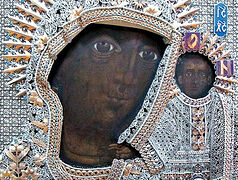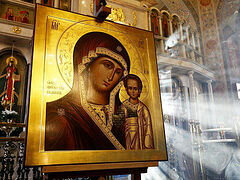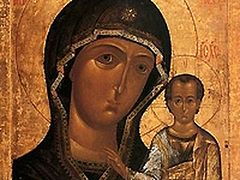The Kazan Icon of the Mother of God
Has a wondrously bright, eternal look.
Wives, daughters and mothers
Stand before it with prayer.
Sergei Gorodetsky
 The Kazan Icon of the Mother of God enjoys unparalleled veneration in Russia. Couples are blessed with this icon before their church wedding, and it is hung by cribs so that the Virgin Mary’s meek face might look with love upon little Christians.
The Kazan Icon of the Mother of God enjoys unparalleled veneration in Russia. Couples are blessed with this icon before their church wedding, and it is hung by cribs so that the Virgin Mary’s meek face might look with love upon little Christians.
Now the cathedral dedicated to this icon once again stands on Red Square in Moscow. It was destroyed in the mid-1930s and restored in our days according to the drawings preserved by the remarkable restoration expert Pyotr Dmitrievich Baranovsky (1892–1984). Now, prayers are again offered up before the Kazan icon in the church located a few steps away from the Resurrection Gate and not far from the monument to Kuzma Minin and Prince Dmitry Pozharsky, who saved Russia in the early seventeenth century.
The Cathedral of the Kazan icon in St. Petersburg, where are buried the remains of Field Marshal Mikhail Kutuzov who defended Russia two centuries later, was returned to the Church as well.
The Kazan Icon is an unshakable reminder of the mercy of the Mother of God to the Russian land and of Her intercession for our country in the most difficult years.
In 1552, the day after the conquest of Kazan by the army of Tsar Ivan IV the Terrible, a cathedral in honor of the Annunciation of the Most Holy Theotokos was founded at his royal command, and a year later the Kazan Diocese was established and its first archbishop, St. Gury, was sent. But more than a quarter of a century later, in 1579, a terrible fire devastated half of the Kazan Kremlin along with the adjoining part of the city. And the Mohammedans interpreted this as a sign that “the Russian God” was unmerciful to people and showed His anger towards them with fire. “The faith of Christ was slandered and profaned,” a chronicler noted. It was then that the Lord showed His mercy. The Mother of God appeared in a dream to Matrona, the nine-year-old daughter of a strelets,1 and ordered her to look for Her icon among the ashes of a house destroyed by fire. No one believed the girl for a long time, but on July 8 (according to the old calendar), tired of fruitless appeals to the city authorities, Matrona’s mother herself took a spade and found an icon wrapped in a shabby sleeve of men’s clothing made of red cloth, in the place indicated by the Queen of Heaven. The Most Pure Virgin’s face was bright and clear, as if the icon had just been painted.
The icon was solemnly translated to the parish Church of St. Nicholas “of Tula”,2 where served a righteous priest—the future Patriarch Hermogenes, who would later die at the hands of the Poles for his faithfulness to Orthodoxy. The future Patriarch, canonized some time after his repose, compiled a detailed account of the miracles of the Kazan icon of the Mother of God.
Tsar Ivan the Terrible ordered a convent for forty nuns to be built on the site where the icon had been found; Matrona and her mother were the first to be tonsured nuns in it. In 1594, the huge Cathedral of the Kazan Icon was founded here. The convent received abundant gifts: church vessels, icons and icon covers. The wonderworking icon was overlaid with royal gifts—gold, precious stones, and pearls. Two centuries later Empress Catherine II presented the Kazan Icon with a new cover, the main decoration of which was her own diamond crown, yielded by the earthly Empress to the Heavenly Queen. In 1798, a new enormous cathedral was founded for keeping the Kazan Icon, and in 1808 it was consecrated. It was destroyed along with the convent in the 1930s. But by that time the icon was no longer there.
By God’s Providence, the appearance of the Kazan Icon under Tsar Ivan IV marked the beginning of Russia’s eastward expansion that lasted for centuries. Through the window to Asia opened by the conquest of Kazan, Orthodoxy enlightened all of Siberia, reaching (along with the Russian State) the shores of the Pacific Ocean. It was as if the Most Pure Virgin blessed this expansion through Her Kazan Icon.
On the night of June 29, 1904, several sacrilegious robbers, led by a certain V. A. Stoyan-Chaikin, climbed into the cathedral, attracted by the precious ornaments of the icon cover. When the thieves were caught, neither the cover nor the wooden icon was with them. The chief robber asserted many times that they had sold the cover to jewelers and thrown the icon into a furnace to see if it was really miraculous. But it was also supposed to be located in the house of the merchant Shevlyagin in Kazan. Many years of investigating and comparing the thieves’ contradictory testimonies brought no real results that time.
It was said that the icon had indeed been bought by Shevlyagin, who emigrated to England after the Russian Revolution and sold it there into private hands. In the 1960s, a Kazan icon in a precious cover appeared in the West. The icon itself turned out to be a twentieth century copy of the original, painted in masterly fashion; but the cover on it, judging by all evidence, was authentic—the same one that was on the wonderworking icon stolen in 1904. Orthodox Americans tried to buy this icon and it was even displayed for a prayer service in an Orthodox church in Boston, where thousands of people saw it but failed to raise enough funds to buy it. As a result, this Kazan Icon, together with the cover that decorates it, was bought in 1970 by Catholics and kept for a long time in Fatima, Portugal, and after 1982 placed in the Vatican.
But if the original cover was in fact not sawn up, then the original miracle-working Kazan icon might have survived, as thousands of Orthodox people continue to believe. Who knows what Chaikin thought about as he slowly faded away for years in his solitary cell at Shlisselburg—where was he lying and where was he telling the truth? It is hard to imagine a lower villainy than burning an icon that myriads of pilgrims had venerated for centuries and to which all of Russia’s most ardent prayers were addressed...
But here is something known for certain: As long as the Kazan icon was kept in splendor at the cathedral of the Convent of the Mother of God in Kazan, nothing threatened Russia from the east. And once the Intercessor disappeared, the country was defeated in the Russo-Japanese War of 1905, which became one of the first blows that would shake and destroy the great empire over the next twelve years. But all turbulent periods end by the grace of God. The Time of Troubles ended, and the current one will end too; and perhaps the miracle-working icon will return to us. When the pious Rurikid Dynasty ended, an interregnum began, accompanied by violence, theft of the treasury, collapse of Russian statehood and many other troubles. And when the Russian people, trusting in the Lord and the prayers of His Mother, resolved to save Russia, the Zemstvo3 army carried a copy of the Kazan Icon of the Mother of God. On October 22, 1612, the Orthodox army entered the Moscow Kremlin—the Kazan icon is also commemorated on that date.
Frightened by Minin and Pozharsky’s volunteer corps, the Poles fled from Moscow. On the next Sunday the Zemstvo army and all the Muscovites marched in solemn procession to the “Lobnoye Mesto” stone platform with the Kazan Icon, sure of its miraculous power.
For it the Cathedral of the Kazan icon was built on Red Square. The Moscow Kazan icon is noticeably smaller than the original. When in 1930 the cathedral on Red Square, which had just been restored by P. D. Baranovsky with the parishioners’ funds, was closed (in 1936 it would be destroyed), this Kazan icon was transferred to the Church of the Theophany in Dorogomilovo near the Kiev Railway Station, which became the cathedral church of Moscow (after the Cathedral of Christ the Savior had been seized by the Renovationists). But by the late 1930s it had been closed and demolished, after which all the traces of this Kazan icon were lost in the museum storerooms. When after the Great Patriotic War (1941–1945) the Theophany Church in Yelokhovo was made the Patriarchal cathedral, pious Christians brought there another copy of the Kazan icon, which remains there to this day. Tradition says that it, too, accompanied the volunteer corps of 1612, but that it was not the miraculous icon from the cathedral on Red Square. So, when this cathedral was renewed, a Kazan icon was painted for it by restorers of the Grabar Art Conservation Center. And prayers are unceasingly uttered before it...
Undoubtedly, the destiny of the third (by the time of discovery) miracle-working Kazan icon—in St. Petersburg—became providential. It appeared in the northern capital in the 1710s and was most likely brought to the Neva banks by the pious Tsarina Paraskeva Feodorovna (1664–1723), Tsar Ivan V’s widow. In the 1730s, the St. Petersburg Kazan icon became famous for various miracles and was the most cherished holy shrine in St. Petersburg. From 1737 it was kept at the Church of the Nativity of the Theotokos on Nevsky Avenue; by 1811, a new cathedral of the Kazan icon was built on its site. A year later, the Patriotic War [War of 1812] broke out. When Alexander I appointed Mikhail Kutuzov commander-in-chief of all the Russian forces, the Field Marshal specially went before his departure to pray at the Cathedral of the Kazan Icon in front of the miraculous icon. People called out to the commander: “Drive out the French!” The Mother of God justified the old soldier’s trust in Her, and the Field Marshal eventually returned to Her icon for eternal rest in the same cathedral.
Having recaptured from the French the silver stolen from Moscow churches, the Don Cossacks presented it as a gift to the Kazan Icon. There was an iconostasis at the cathedral cast from this silver with the inscription: “A generous offering of the Don army.” Right there, at the cathedral’s majestic colonnade, monuments to Mikhail Kutuzov and Michael Barclay de Tolly were erected. On March 17, 1922 this iconostasis was dismantled, and the Bolsheviks confiscated 129 pounds of silver and over thirty-seven pounds of gold; in late 1922, the decorations from the Kazan icon were extracted and sold abroad.
A year later, in 1923, the Renovationists, who knew how to wrangle from the godless authorities the largest and most magnificent churches, seized the Cathedral of the Kazan Icon. But the miracle-working icon was saved, first ending up at the church of the Smolensk Cemetery on Vasilyevsky Island, and since 1940 at the right kliros of the Prince Vladimir Cathedral in the historical Petrogradskaya Storona neighborhood.
This icon is in the late sixteenth-century-Moscow style, close in time to the original from Kazan. It worked another miracle during the Great Patriotic War. The aged Metropolitan Elias of Lebanon had a vision in which the Mother of God ordered him to convey Her will to the Kremlin rulers: to go around the cities encircled by the Nazis with the miracle-working Kazan icon. According to legend, the godless rulers, frightened by their military failures, did not dare argue. It is known for certain that when in 1947 Metropolitan Elias visited Leningrad, he was greeted with truly royal honors (many city people judged by the number of cars and guards decided that Stalin was arriving), and this pious Eastern hierarch gave a new golden crown to the Kazan Icon.
The Cathedral of the Kazan Icon on Nevsky Avenue has long been returned to the Church, but whether the wonderworking icon will return there depends on the will of the Queen of Heaven Herself alone.
Several more copies of the Kazan icon are venerated throughout the Russian Church: the Bogorodskoye-Ufa, Vysochino, Vysha, Vyazniki, Kaplunovka, Nizhny Lomov, Tambov, Tobolsk, and Yaroslavl Kazan icons; while locally venerated Kazan Icons in Russian cities and villages, parishes and families of Orthodox Christians, are so numerous that it is impossible to list them.
Troparion, tone 4
O fervent Intercessor, Mother of the Lord Most High, thou dost pray to thy Son Christ our God and save all who seek thy protection. O Sovereign Lady and Queen, help and defend all of us who in trouble and trials, in pain and burdened with many sins, stand in thy presence before thine icon, and who pray with compunction, contrition and tears and with unfailing hope in thee. Grant what is good for us, deliverance from evil, and save us all, O Virgin Mother of God, for thou art a divine protection to thy servants.
Prayer
O Most Holy Sovereign Lady Theotokos! With fear, faith and love, falling down before thy holy image, we pray to thee: turn not thy face away from those who have recourse to thee. O merciful Mother, beseech thy Son and our God, the Lord Jesus Christ, that He may preserve our land in peace, and keep His Holy Church unshaken by unbelief, heresy and schism. We have no other help, no other hope, but thee, O Most Pure Virgin. For thou art the all-powerful help and Intercessor of Christians. Deliver everyone who prays to thee with faith from sinful falls, from the slander of evil people, from all temptations, sorrows, troubles and sudden death. Grant us the spirit of contrition, humility of heart, purity of mind, correction of sinful lives, and forgiveness of sins. May we all, gratefully singing of thy greatness, be found worthy of the Kingdom of Heaven, and there with all the saints glorify the most honorable and magnificent name of the Father, the Son, and the Holy Spirit. Amen.
From the book, All of Creation Rejoices in Thee



